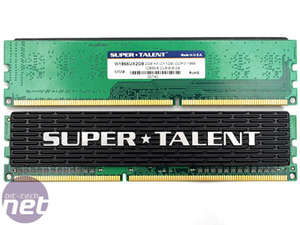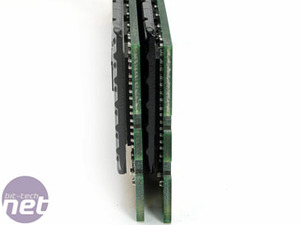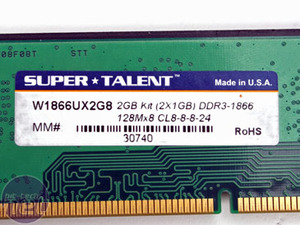
Super Talent W1866UX2G8
Manufacturer: Super TalentUK Price (as reviewed): £359
US Price (as reviewed): $580
Super Talent W1866UX2G8 Details:
Kit: 2 x 240-pin DDR3 Double Sided DIMMModule Size: 2GB Dual Channel Kit (2 x 1GB)
Module Code: W1866UX2G8
Rated Speed: 1,866MHz DDR3
Rated Timings: 8-8-8-24 (CAS-tRCD-tRP-tRAS)
Rated Voltage: 2.0V
Memory Chips: Micron D9GTR
XMP?: No, but all "Project X" modules available from this month of 1,600MHz+ will include XMP profiles.
Super Talent is not quite in the same league for performance memory as Corsair (at least in the UK), but it is still making significant strides on the storage front by producing notebook and desktop memory, memory sticks, MP3 players and SSD devices, too. The Elite brand in particular offer a massive read rate of 100MB/s and write speed of 80MB/s, which is faster than most standard hard drives, but they're limited to just 32GB in size.
The DDR3 modules we're looking at today feature the same Micron D9GTR memory chips as the Corsair, and are clocked slightly higher at 1,866Mhz but at a lower latency of 8-8-8-24. Super Talent does offer a pair of 1,800MHz sticks (W1800UX2GP) with a latency of 7-7-7-21 as well - is the extra 66MHz really worth dropping all that latency? But it's not a real trade off - you can likely use either set of modules at either rating because, again, they use Micron D9s.
The single sided DIMMs are in a 128M x 8 arrangement, so the simple heatspreader is just stuck to the side that matters. In some ways it does make the modules look less "convincing" as performance memory, and they don't look as good when installed in a case either. OCZ Reaper, FlexXLC or Corsair DHX each look very unique, and when you're spending in excess of £350 on a pair of sticks you ussually want them to look good. Ideally they don't want to just look "the business", they want to look the bizness!
In addition, because the heatspreaders are slightly taller than the actual modules it means that when you push down (or pull out) the modules from the motherboard you're actually pressing on the heatspreader only - so subsequently, the memory chips and solder joints are stressed. Really you want to minimise this by translating the force directly down into the socket through the PCB, however every other set of modules with heatspreaders/heatsinks also suffers the same problem; the vast majority are dual-sided though, meaning the force is evenly spread between them. There's also no PCB cooling either in comparison to the DHX technology of Corsair, and FlexXLC or Reaper modules from OCZ feature a far larger mass of metal to suck the heat from the memory chips.
Thankfully though Super Talent has recently released "Project X" modules that feature large (DHX-esq) aluminium heatsinks, more aggressive 7-7-7-21 latencies and XMP profiles. These heatsinks are not quite as large as OCZ's and they don't include PCB cooling like Corsair DHX, but at least you can put two sticks next to each other, unlike Team Group Xtreme.

MSI MPG Velox 100R Chassis Review
October 14 2021 | 15:04












Want to comment? Please log in.